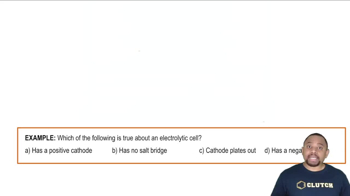In the Brønsted–Lowry concept of acids and bases, acid– base reactions are viewed as proton-transfer reactions. The stronger the acid, the weaker is its conjugate base. If we were to think of redox reactions in a similar way, what particle would be analogous to the proton? Would strong oxidizing agents be analogous to strong acids or strong bases? [Sections 20.1 and 20.2]
Ch.20 - Electrochemistry
Chapter 20, Problem 3b
The diagram that follows represents a molecular view of a process occurring at an electrode in a voltaic cell.

(b) Is the electrode the anode or cathode?

 Verified step by step guidance
Verified step by step guidance1
Identify the process occurring at the electrode by analyzing the molecular view. Notice that atoms are leaving the electrode surface, indicating a loss of material.
Recognize that the loss of atoms from the electrode surface suggests oxidation, as atoms are losing electrons and becoming ions.
Recall that in a voltaic cell, oxidation occurs at the anode. Therefore, the electrode where atoms are leaving must be the anode.
Confirm that the electrode is the anode by noting that oxidation (loss of electrons) is taking place, which is consistent with the behavior of an anode in a voltaic cell.
Conclude that the electrode depicted in the molecular view is the anode, as it is the site of oxidation where atoms are losing electrons and becoming ions.

Verified video answer for a similar problem:
This video solution was recommended by our tutors as helpful for the problem above.
Video duration:
1mWas this helpful?
Key Concepts
Here are the essential concepts you must grasp in order to answer the question correctly.
Voltaic Cell
A voltaic cell, also known as a galvanic cell, is an electrochemical cell that converts chemical energy into electrical energy through spontaneous redox reactions. It consists of two electrodes, an anode and a cathode, immersed in an electrolyte solution. The flow of electrons from the anode to the cathode generates an electric current, which can be harnessed for external use.
Recommended video:
Guided course

The Electrolytic Cell
Anode and Cathode
In a voltaic cell, the anode is the electrode where oxidation occurs, meaning it loses electrons, while the cathode is where reduction takes place, gaining electrons. The anode is typically negative in a voltaic cell, as it donates electrons to the external circuit, while the cathode is positive, attracting electrons. Understanding the roles of these electrodes is crucial for analyzing the cell's operation.
Recommended video:
Guided course

Electrolytic Cell Components Example
Electron Transfer
Electron transfer is a fundamental process in electrochemistry, where electrons move from one species to another during redox reactions. In the context of a voltaic cell, this transfer occurs between the anode and cathode, facilitating the flow of electric current. The diagram illustrates this movement, highlighting the importance of electron flow in generating electrical energy from chemical reactions.
Recommended video:
Guided course

Electron Geometry
Related Practice
Textbook Question
3
views
Textbook Question
The diagram that follows represents a molecular view of a process occurring at an electrode in a voltaic cell.
(a) Does the process represent oxidation or reduction?
3
views
Textbook Question
The diagram that follows represents a molecular view of a process occurring at an electrode in a voltaic cell.
(c) Why are the atoms in the electrode represented by larger spheres than those in the solution? [Section 20.3]
Textbook Question
Assume that you want to construct a voltaic cell that uses the following half-reactions: A2+1aq2 + 2 e- ¡ A1s2 Ered ° = -0.10 V B2+1aq2 + 2 e- ¡ B1s2 E°red = -1.10 V You begin with the incomplete cell pictured here in which the electrodes are immersed in water.
(a) What additions must you make to the cell for it to generate a standard emf?
1
views
